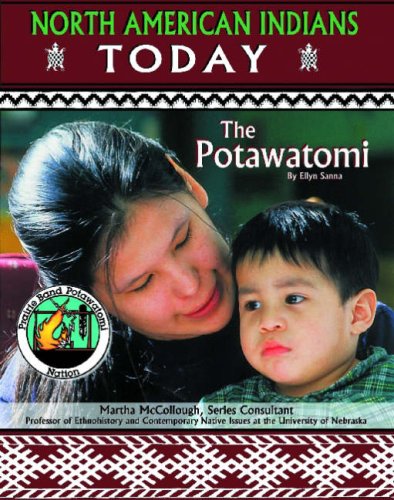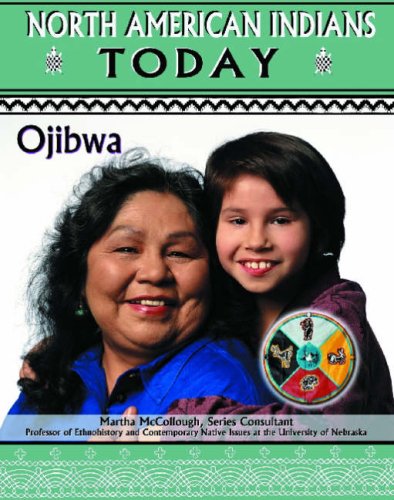-
Potawatomi
Ellyn Sanna, Martha McCollough
Library Binding (Mason Crest Publishers, Sept. 1, 2003)North American Indians are not merely a historical topic. Instead, today's Native Americans are living, productive members of North American society. The contributions of the various Indian cultures enrich our lives in countless ways. For instance, "Indians have the strongest sense of place of anyone in the world," says Amy Mossett, a Native scholar (quoted in the New York Times). This sense of place is reflected in American Indians' connection to the Earth, an intimate relationship that has concrete implications for the way we handle environmental issues. Indians' connection to the traditions of their ancestors is also strong. At the same time, however, Native Americans are modern people confronting the challenges of today's world. They gain strength for the present from their deep foundations in the past. What's more, Native traditions and wisdom have much to offer us all. North American Indians Today portrays contemporary Indians within the present-day context of their relationship to their land, their past, their traditions, and their 21-st century realities. The heritage and history of each tribe is given as background to chapters on the current government, society, culture, religion, contributions, challenges, and goals of each tribe. Each volume was written with the help of Native people, and tribal leaders and scholars reviewed and approved the text for their tribes. The series consultant, a Native American expert from the University of Nebraska, ensured that the text is free from cultural bias. This series' respectful and accurate text, as well as the color photographs and Native artwork, will give readers a broader understanding of today's North American Indians, theirconnection to their land and their past, and their contributions to our modern-day world. Z+
Z+
-
The Abenaki
Colin G. Calloway, Frank W. Porter
Library Binding (Chelsea House Pub, Feb. 1, 1989)Describes the history of the Abenaki, looks at their culture, and recounts their interaction with European settlers Z+
Z+
-
Apache
Kenneth McIntosh, Martha McCollough
Library Binding (Mason Crest Publishers, Sept. 1, 2003)North American Indians are not merely a historical topic. Instead, today's Native Americans are living, productive members of North American society. The contributions of the various Indian cultures enrich our lives in countless ways. For instance, "Indians have the strongest sense of place of anyone in the world," says Amy Mossett, a Native scholar (quoted in the New York Times). This sense of place is reflected in American Indians' connection to the Earth, an intimate relationship that has concrete implications for the way we handle environmental issues. Indians' connection to the traditions of their ancestors is also strong. At the same time, however, Native Americans are modern people confronting the challenges of today's world. They gain strength for the present from their deep foundations in the past. What's more, Native traditions and wisdom have much to offer us all. North American Indians Today portrays contemporary Indians within the present-day context of their relationship to their land, their past, their traditions, and their 21-st century realities. The heritage and history of each tribe is given as background to chapters on the current government, society, culture, religion, contributions, challenges, and goals of each tribe. Each volume was written with the help of Native people, and tribal leaders and scholars reviewed and approved the text for their tribes. The series consultant, a Native American expert from the University of Nebraska, ensured that the text is free from cultural bias. This series' respectful and accurate text, as well as the color photographs and Native artwork, will give readers a broader understanding of today's North American Indians, theirconnection to their land and their past, and their contributions to our modern-day world. Z
Z
-
Iroquois
Kenneth McIntosh, Marsha McIntosh, Martha McCollough
Library Binding (Mason Crest, Dec. 1, 2003)Discusses the history, heritage, people, and contemporary life of the Iroquois Indians.
-
Native Peoples of the Northwest
Krystyna Poray Goddu
Paperback (LernerClassroom, Aug. 1, 2016)A thin strip of land and islands makes up the Pacific Northwest coast of the United States and Canada. This region has long been home to many groups of native peoples who spoke different languages and had distinct cultural practices. The native peoples of the Northwest thrived in this land of rocky beaches and cedar trees. • The Chinook developed a special language for trading with other nations. • The Kwakwaka'wakw created masks that could show two different faces. • The Bella Coola had a secret society that performed in a four-night winter ceremony. Many native peoples still live in the Northwest and continue to fish, carve totem poles, and work to preserve their land and cultures. Learn more about the unique history and cultures of the native peoples of the Northwest. X
X
-
The Lumbee
Adolph L. Dial, Frank W. Porter
Library Binding (Chelsea House Pub, March 1, 1993)Discusses the history of the second largest Indian group in the United States, whose origin is traced to the Hatteras Indians who supposedly adopted the English settlers of the Roanoke colony into their tribe
-
The Pawnee
Theresa Jensen Lacey
Library Binding (Chelsea House Pub, Sept. 1, 2005)The Pawnee originally called Kansas and Nebraska home and consist of four autonomous bands: the Chaui, Pitahawirata, Kitkahahki, and Skiri. They are well known for serving as scouts for the U.S. Army in helping to track down their longtime enemies, the Cheyenne and Sioux, during the Indian wars of the 1870s and '80s-a role that was portrayed in the 1990 movie "Dances with Wolves."
-
The Hopi
Nancy Bonvillain
Library Binding (Chelsea House Pub, Sept. 1, 2004)Examines the history, culture, changing fortunes, and current situation of the Hopi Indians.



